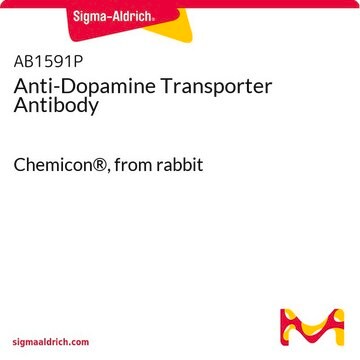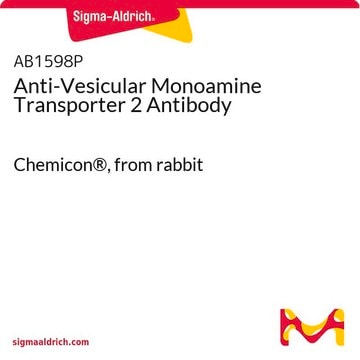MAB369
Anti-Dopamine Transporter Antibody, NT, clone DAT-Nt
culture supernatant, clone DAT-Nt, Chemicon®
Sinónimos:
DAT
About This Item
Productos recomendados
origen biológico
rat
Nivel de calidad
forma del anticuerpo
culture supernatant
tipo de anticuerpo
primary antibodies
clon
DAT-Nt, monoclonal
reactividad de especies
rat, human, mouse, monkey
fabricante / nombre comercial
Chemicon®
técnicas
immunocytochemistry: suitable
immunohistochemistry: suitable
western blot: suitable
isotipo
IgG2aκ
Nº de acceso NCBI
Nº de acceso UniProt
Condiciones de envío
dry ice
modificación del objetivo postraduccional
unmodified
Información sobre el gen
human ... SLC6A3(6531)
Descripción general
Especificidad
Inmunógeno
Aplicación
Neuroscience
Ion Channels & Transporters
Immunohistochemistry: 4% paraformaldehyde fixed tissue (care should be taken not to over-fix tissue); perfusion followed by less than 90 minutes post-fixation, then cryoprotect. Suggested working dilution 1:1,000-1:10,000. If using on rat tissue, absorbed anti-rat secondary antibodies are recommended, and the use of rat PAP systems, or ABC detection will enhance sensitivity.
Immunocytochemistry: 1:5,000 to 1:10,000.
Immunoblotting (not recommended for use on rat)
Optimal working dilutions and protocols must be determined by end user.
IMMUNOHISTOCHEMISTRY PROTOCOL FOR MAB369
This antibody has been used successfully on 30 μm, free floating, 4% paraformaldehyde fixed mouse brain tissue. All steps are performed under constant agitation. Suggested protocol follows.
1) 3 x 10 minute washes in TBS (with or without 0.25% Triton).
2) Incubate for 30 minutes in TBS with 3% serum (same as host from secondary antibody).
3) Incubate primary antibody diluted appropriately in TBS with 1% serum (same as host from secondary antibody) (with or without 0.25% Triton) for 2 hours at room temperature followed by 16 hours at 4°C.
4) 3 x 10 minute washes in TBS.
5) Incubate with secondary antibody diluted appropriately in TBS with 1% serum (same as host from secondary antibody).
6) 3 x 10 minute washes in TBS.
7) ABC Elite (1:200 Vector Labs) in TBS.
8) 2 x 10 minute washes in TBS.
9) 1 x 10 minute wash in phosphate buffer (no saline).
10) DAB reaction with 0.06% NiCl added for intensification.
11) 2 x 10 minute washes in PBS.
12) 1 x 10 minute wash in phosphate buffer (no saline).
Descripción de destino
Forma física
Almacenamiento y estabilidad
Nota de análisis
Positive Control: Brain (caudate, putamen, and nucleus accumbens) tissue
Información legal
Cláusula de descargo de responsabilidad
Not finding the right product?
Try our Herramienta de selección de productos.
Opcional
Código de clase de almacenamiento
10 - Combustible liquids
Clase de riesgo para el agua (WGK)
WGK 1
Punto de inflamabilidad (°F)
Not applicable
Punto de inflamabilidad (°C)
Not applicable
Certificados de análisis (COA)
Busque Certificados de análisis (COA) introduciendo el número de lote del producto. Los números de lote se encuentran en la etiqueta del producto después de las palabras «Lot» o «Batch»
¿Ya tiene este producto?
Encuentre la documentación para los productos que ha comprado recientemente en la Biblioteca de documentos.
Los clientes también vieron
Nuestro equipo de científicos tiene experiencia en todas las áreas de investigación: Ciencias de la vida, Ciencia de los materiales, Síntesis química, Cromatografía, Analítica y muchas otras.
Póngase en contacto con el Servicio técnico










